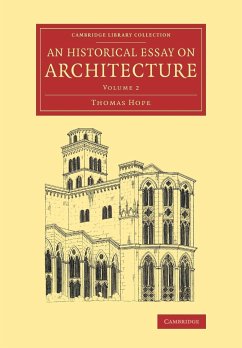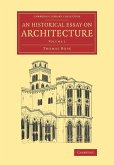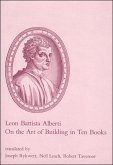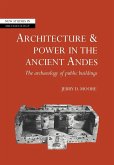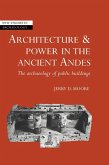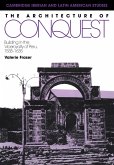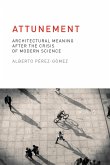- Broschiertes Buch
- Merkliste
- Auf die Merkliste
- Bewerten Bewerten
- Teilen
- Produkt teilen
- Produkterinnerung
- Produkterinnerung
The 1840 third edition of a work tracing the evolution of architecture since antiquity, accompanied by drawings and an analytical index.
Andere Kunden interessierten sich auch für
![An Historical Essay on Architecture An Historical Essay on Architecture]() Thomas HopeAn Historical Essay on Architecture55,99 €
Thomas HopeAn Historical Essay on Architecture55,99 €![On the Art of Building in Ten Books On the Art of Building in Ten Books]() Leon Battista AlbertiOn the Art of Building in Ten Books64,99 €
Leon Battista AlbertiOn the Art of Building in Ten Books64,99 €![Architecture and Power in the Ancient Andes Architecture and Power in the Ancient Andes]() Jerry D. MooreArchitecture and Power in the Ancient Andes61,99 €
Jerry D. MooreArchitecture and Power in the Ancient Andes61,99 €![Architecture and Power in the Ancient Andes Architecture and Power in the Ancient Andes]() Jerry D. MooreArchitecture and Power in the Ancient Andes108,99 €
Jerry D. MooreArchitecture and Power in the Ancient Andes108,99 €![The Architecture of Conquest The Architecture of Conquest]() Valerie FraserThe Architecture of Conquest46,99 €
Valerie FraserThe Architecture of Conquest46,99 €![Absolute Beginners Absolute Beginners]() Iñaki ÁbalosAbsolute Beginners38,00 €
Iñaki ÁbalosAbsolute Beginners38,00 €![Attunement Attunement]() Alberto Perez-GomezAttunement37,99 €
Alberto Perez-GomezAttunement37,99 €-
-
-
The 1840 third edition of a work tracing the evolution of architecture since antiquity, accompanied by drawings and an analytical index.
Hinweis: Dieser Artikel kann nur an eine deutsche Lieferadresse ausgeliefert werden.
Hinweis: Dieser Artikel kann nur an eine deutsche Lieferadresse ausgeliefert werden.
Produktdetails
- Produktdetails
- Verlag: Cambridge University Press
- Seitenzahl: 204
- Erscheinungstermin: 16. Januar 2014
- Englisch
- Abmessung: 244mm x 170mm x 11mm
- Gewicht: 362g
- ISBN-13: 9781108068420
- ISBN-10: 1108068421
- Artikelnr.: 40454059
- Herstellerkennzeichnung
- Libri GmbH
- Europaallee 1
- 36244 Bad Hersfeld
- gpsr@libri.de
- Verlag: Cambridge University Press
- Seitenzahl: 204
- Erscheinungstermin: 16. Januar 2014
- Englisch
- Abmessung: 244mm x 170mm x 11mm
- Gewicht: 362g
- ISBN-13: 9781108068420
- ISBN-10: 1108068421
- Artikelnr.: 40454059
- Herstellerkennzeichnung
- Libri GmbH
- Europaallee 1
- 36244 Bad Hersfeld
- gpsr@libri.de
Preface
1. Introduction
2. Origin and nature of the Egyptian style of architecture
3. Origin of the architecture of the Greeks
4. Influence upon architecture of habit and religion
5. Nature and character of the different orders of Grecian architecture
6. Natural and adventitious circumstances by which Grecian architecture was affected
7. On the origin of the arch
8. Decay of the architecture of the Greeks, and progress of that of the Romans
9. Effect upon architecture of the introduction of Christianity
10. Effect upon ancient architecture of the want of glass
11. Some account of round or polygonal buildings
12. Rise and progress of the architecture of Byzantium
13. Derivation of the Persian, Mohammedan, and Moorish architecture from that of Byzantium
14. Derivation of Russian architecture from that of Byzantium
15. Destruction of pagan works of art
16. Symbols used by the early Christians
17. Heathen customs kept up or emulated by the Christians
18. Schism between the Greek and Latin churches
19. Sepulchral architecture
20. Early styles of architecture on this side of the Alps derived from Italy
21. Investigation of the circumstances which, towards the end of the tenth century, affected architecture generally and extensively throughout Europe
22. Lombard style of architecture
23. Progress of the art of constructing arches and vaults
24. Forms of the absis, entrance, cupola, spire, and steeple usually seen in Lombard architecture
25. Lombard monastic architecture
26. Private defensive architecture of the ninth and tenth centuries
27. Lombard civic architecture
28. Allegorical and other ornamental additions to Lombard architecture
29. On the use of brick
30. Doors of churches
31. A list of churches in the Lombard style
32. Some account of the characteristics of the pointed style
33. The question of the person by whom, or the place where, the pointed arch was invented, not to be solved
34. Examination of various conjectures on the subject of the change from round to pointed architecture
35. The author's theory respecting the invention and adoption of pointed architecture
36. A brief examination of various conjectures as to the country in which pointed architecture originated
37. Inquiry into the claims of England to the invention of pointed architecture
38. Inquiry into the claims of France and Italy
39. Inquiry into the claims of Germany
40. A short account of some developments of the pointed style, religious and civic
41. Diffusion of the pointed style through France, England, Spain, Portugal, and Italy
42. A list of remarkable edifices in the pointed style
43. Local peculiarities of architecture
44. Causes which produced the decline of pointed architecture
45. Characteristics of the resumed style of the ancients
46. Adoption throughout Europe of the resumed style of the ancients
47. A list of edifices in the cinque-cento style
48. Remarks upon architecture since the time of Michael Angelo
Index.
1. Introduction
2. Origin and nature of the Egyptian style of architecture
3. Origin of the architecture of the Greeks
4. Influence upon architecture of habit and religion
5. Nature and character of the different orders of Grecian architecture
6. Natural and adventitious circumstances by which Grecian architecture was affected
7. On the origin of the arch
8. Decay of the architecture of the Greeks, and progress of that of the Romans
9. Effect upon architecture of the introduction of Christianity
10. Effect upon ancient architecture of the want of glass
11. Some account of round or polygonal buildings
12. Rise and progress of the architecture of Byzantium
13. Derivation of the Persian, Mohammedan, and Moorish architecture from that of Byzantium
14. Derivation of Russian architecture from that of Byzantium
15. Destruction of pagan works of art
16. Symbols used by the early Christians
17. Heathen customs kept up or emulated by the Christians
18. Schism between the Greek and Latin churches
19. Sepulchral architecture
20. Early styles of architecture on this side of the Alps derived from Italy
21. Investigation of the circumstances which, towards the end of the tenth century, affected architecture generally and extensively throughout Europe
22. Lombard style of architecture
23. Progress of the art of constructing arches and vaults
24. Forms of the absis, entrance, cupola, spire, and steeple usually seen in Lombard architecture
25. Lombard monastic architecture
26. Private defensive architecture of the ninth and tenth centuries
27. Lombard civic architecture
28. Allegorical and other ornamental additions to Lombard architecture
29. On the use of brick
30. Doors of churches
31. A list of churches in the Lombard style
32. Some account of the characteristics of the pointed style
33. The question of the person by whom, or the place where, the pointed arch was invented, not to be solved
34. Examination of various conjectures on the subject of the change from round to pointed architecture
35. The author's theory respecting the invention and adoption of pointed architecture
36. A brief examination of various conjectures as to the country in which pointed architecture originated
37. Inquiry into the claims of England to the invention of pointed architecture
38. Inquiry into the claims of France and Italy
39. Inquiry into the claims of Germany
40. A short account of some developments of the pointed style, religious and civic
41. Diffusion of the pointed style through France, England, Spain, Portugal, and Italy
42. A list of remarkable edifices in the pointed style
43. Local peculiarities of architecture
44. Causes which produced the decline of pointed architecture
45. Characteristics of the resumed style of the ancients
46. Adoption throughout Europe of the resumed style of the ancients
47. A list of edifices in the cinque-cento style
48. Remarks upon architecture since the time of Michael Angelo
Index.
Preface
1. Introduction
2. Origin and nature of the Egyptian style of architecture
3. Origin of the architecture of the Greeks
4. Influence upon architecture of habit and religion
5. Nature and character of the different orders of Grecian architecture
6. Natural and adventitious circumstances by which Grecian architecture was affected
7. On the origin of the arch
8. Decay of the architecture of the Greeks, and progress of that of the Romans
9. Effect upon architecture of the introduction of Christianity
10. Effect upon ancient architecture of the want of glass
11. Some account of round or polygonal buildings
12. Rise and progress of the architecture of Byzantium
13. Derivation of the Persian, Mohammedan, and Moorish architecture from that of Byzantium
14. Derivation of Russian architecture from that of Byzantium
15. Destruction of pagan works of art
16. Symbols used by the early Christians
17. Heathen customs kept up or emulated by the Christians
18. Schism between the Greek and Latin churches
19. Sepulchral architecture
20. Early styles of architecture on this side of the Alps derived from Italy
21. Investigation of the circumstances which, towards the end of the tenth century, affected architecture generally and extensively throughout Europe
22. Lombard style of architecture
23. Progress of the art of constructing arches and vaults
24. Forms of the absis, entrance, cupola, spire, and steeple usually seen in Lombard architecture
25. Lombard monastic architecture
26. Private defensive architecture of the ninth and tenth centuries
27. Lombard civic architecture
28. Allegorical and other ornamental additions to Lombard architecture
29. On the use of brick
30. Doors of churches
31. A list of churches in the Lombard style
32. Some account of the characteristics of the pointed style
33. The question of the person by whom, or the place where, the pointed arch was invented, not to be solved
34. Examination of various conjectures on the subject of the change from round to pointed architecture
35. The author's theory respecting the invention and adoption of pointed architecture
36. A brief examination of various conjectures as to the country in which pointed architecture originated
37. Inquiry into the claims of England to the invention of pointed architecture
38. Inquiry into the claims of France and Italy
39. Inquiry into the claims of Germany
40. A short account of some developments of the pointed style, religious and civic
41. Diffusion of the pointed style through France, England, Spain, Portugal, and Italy
42. A list of remarkable edifices in the pointed style
43. Local peculiarities of architecture
44. Causes which produced the decline of pointed architecture
45. Characteristics of the resumed style of the ancients
46. Adoption throughout Europe of the resumed style of the ancients
47. A list of edifices in the cinque-cento style
48. Remarks upon architecture since the time of Michael Angelo
Index.
1. Introduction
2. Origin and nature of the Egyptian style of architecture
3. Origin of the architecture of the Greeks
4. Influence upon architecture of habit and religion
5. Nature and character of the different orders of Grecian architecture
6. Natural and adventitious circumstances by which Grecian architecture was affected
7. On the origin of the arch
8. Decay of the architecture of the Greeks, and progress of that of the Romans
9. Effect upon architecture of the introduction of Christianity
10. Effect upon ancient architecture of the want of glass
11. Some account of round or polygonal buildings
12. Rise and progress of the architecture of Byzantium
13. Derivation of the Persian, Mohammedan, and Moorish architecture from that of Byzantium
14. Derivation of Russian architecture from that of Byzantium
15. Destruction of pagan works of art
16. Symbols used by the early Christians
17. Heathen customs kept up or emulated by the Christians
18. Schism between the Greek and Latin churches
19. Sepulchral architecture
20. Early styles of architecture on this side of the Alps derived from Italy
21. Investigation of the circumstances which, towards the end of the tenth century, affected architecture generally and extensively throughout Europe
22. Lombard style of architecture
23. Progress of the art of constructing arches and vaults
24. Forms of the absis, entrance, cupola, spire, and steeple usually seen in Lombard architecture
25. Lombard monastic architecture
26. Private defensive architecture of the ninth and tenth centuries
27. Lombard civic architecture
28. Allegorical and other ornamental additions to Lombard architecture
29. On the use of brick
30. Doors of churches
31. A list of churches in the Lombard style
32. Some account of the characteristics of the pointed style
33. The question of the person by whom, or the place where, the pointed arch was invented, not to be solved
34. Examination of various conjectures on the subject of the change from round to pointed architecture
35. The author's theory respecting the invention and adoption of pointed architecture
36. A brief examination of various conjectures as to the country in which pointed architecture originated
37. Inquiry into the claims of England to the invention of pointed architecture
38. Inquiry into the claims of France and Italy
39. Inquiry into the claims of Germany
40. A short account of some developments of the pointed style, religious and civic
41. Diffusion of the pointed style through France, England, Spain, Portugal, and Italy
42. A list of remarkable edifices in the pointed style
43. Local peculiarities of architecture
44. Causes which produced the decline of pointed architecture
45. Characteristics of the resumed style of the ancients
46. Adoption throughout Europe of the resumed style of the ancients
47. A list of edifices in the cinque-cento style
48. Remarks upon architecture since the time of Michael Angelo
Index.

